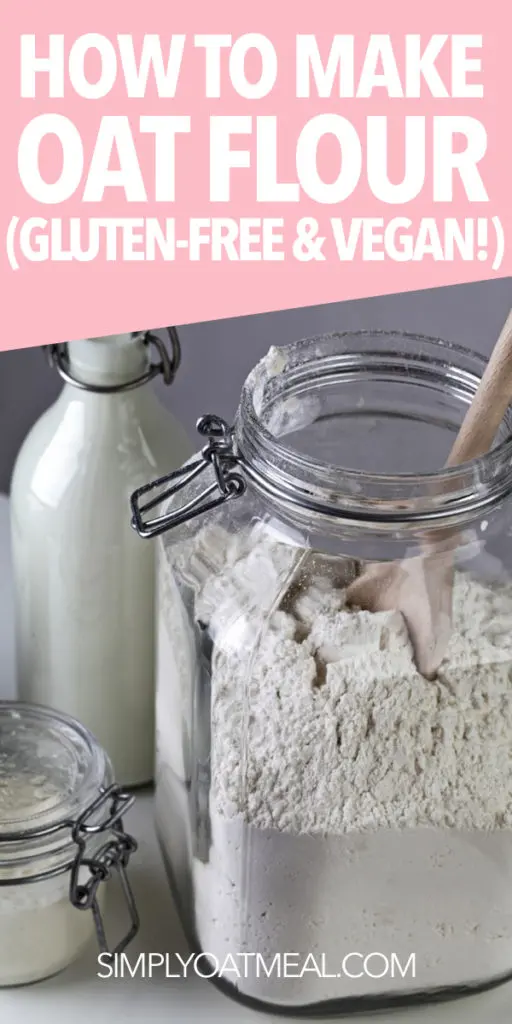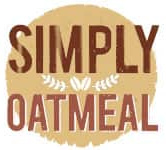Sometimes we have oat flour available or we simply don’t want to buy that extra ingredient for the pantry. If you’re looking for the next best thing, make oat flour at home the easy way. This is how to make oat flour at home!
As gluten-free recipe options continue to be explored, oat flour seems to be used more frequently in cooking and baking recipes. In case you don’t have oat flour readily available, let’s learn how to prepare a small batch in just a few minutes.

Oat flour is made by finely grinding whole oat groats in large mills. Oat groats are the kernels of the whole grain that have been removed from the inedible outer layer or the husk.
In addition, oat groats contain the bran, endosperm, and the germ of the whole grain oat. Therefore, oat flour retains the entire nutritional availability.
Oat flour is great for these Oat Flour Waffles and Oat Flour Pancakes!
How do you make oat flour at home?

Although it’s not exactly the same thing, this DIY oat flour will have aroma, consistency, and flavor that are similar, just a bit milder.
Truth be told, this process actually requires having rolled oats or quick oats. Without any oats, there is no way to make oat flour.
Both old-fashioned rolled oats and quick oats have already been steamed and passed through large rolling mills. The resulting product is more delicate and is not as hard as oat groats or steel-cut oats.
The most efficient way to make oat flour is by using a food processor. The entire process should take less than 60 seconds depending on the speed and power of your food processor.
Pulse the regular or quick oats until they are ground into a fine powder. Scrap down the sides to ensure all the pieces have been fully processed.
For 1 cut of flour, you will need 1¼ cup of rolled oats or quick oats.
If you prefer to buy it, I love Anthony’s Oat Flour!
How to make oat flour without a food processor?
Is it possible to make oat flour without a food processor? The answer is yes, here are a few options so that you can still make oat flour on your own.
Can I grind oats in a blender? A high-speed blender will be the next best option to make oat flour at home.
Again, we will use either rolled oats or quick oats because they have already been steamed and rolled flat. As a result, they are easier to grind without industrial equipment.
Use a high-speed blender to grind the rolled oats into a fine powder. Scrap down the side in between pulses, but this should only take about 60 seconds based on the speed and power of the blender.
1¼ cup of rolled oats should yield about 1 cup of finely ground oat flour.
Can you make oat flour in a Nutribullet? Most blenders should work well for this process. Whether you have a Vitamix, NutriBullet, or Magic Bullet, you should still be able to make oat flour without a food processor.
It’s important to recognize the power and capacity of your appliance before beginning. If the reservoir is small and lacks extreme force, then don’t overload the container.
Work in small batches that require less force and gradually work through the required amount to complete the recipe. If you’re doing a handful at a time, the machine should be able to handle the load.
Can you use steel-cut oats?
Steel cut oats are whole oat groats that have been cut into two or three pieces. As a result, they are not generally used for making oat flour at home because they perform better under extreme pressure in a grain mill.
Because of the distinguishable differences between steel cut, rolled and quick oats, it’s most common to use rolled oats to make oat flour.
You may also be tempted to use instant oats. However, they are not for making oat flour because they have already been fully cooked.
Is oat flour gluten-free?
Oats are a nutritious source of plant-based protein, high fiber, and multiple vitamins and minerals. Oats are powerful and work well for a balanced healthy diet.
Because oats are naturally gluten-free, oat flour is also perfectly safe for people with a gluten sensitivity. However, it is still important to purchase gluten-free certified oat flour to ensure the harvesting and processing equipment have not been contaminated.
And that is truly just one of the several benefits of oats.
As a result, people are finding new uses for oats within food.
Oat flour is just one of the types of oats that are readily available in the market. But if we don’t have any oat flour in the pantry, are you able to make it?
Can you eat homemade oat flour raw?
There is a larger amount of risk associated with eating manufactured oat flour. It has not been cooked, and therefore you have a chance of encountering a food-borne bacteria like E. coli.
On the contrary, homemade oat flour made from rolled oats has already been partially cooked. The rolled oats process begins by steaming the oats before passing them through large rolling mills.
The oats have been cooked and therefore are no longer raw. So when you make oat flour from regular oats it is safe to eat.
However, some people do face side effects to oats after eating. Research indicates the possibility of sensitivity to oats that is similar to symptoms associated with gluten intolerance.
If you experience a similar oat allergy, then consult a medical professional for more answers.
You May Also Like
If you enjoyed this post about how to make oat flour, please leave a comment below!

Big L
Saturday 21st of November 2020
If I substitute oat flour for oat fiber, what would be the equal measurement...i.e., 1/2 cup of oat fiber equals ........ oat flour?
Joshua
Sunday 22nd of November 2020
Oat flour and oat fiber are not interchangeable ingredients for many recipes. I would have to know more about the recipe you are following to provide a clear and concise answer to this question. Oat fiber is the undigestible fibrous hull or husk of the oat grain. It is keto friendly because it is completely insoluble fiber. Oat flour is made from the oat groat and is commonly used in baked goods.